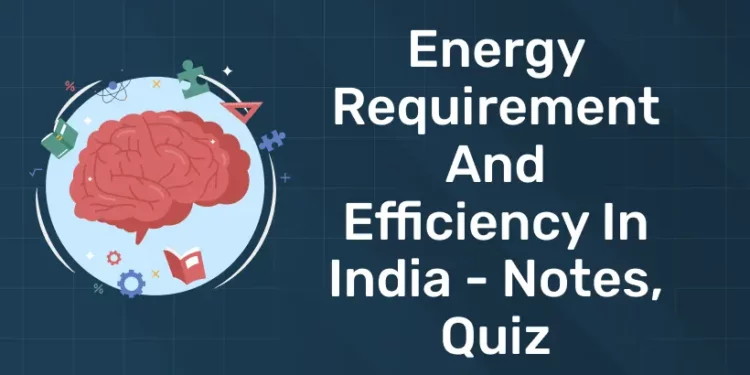Table of Contents
Energy Requirement and Efficiency is defined as utilizing less energy to do the same task, which lowers pollutants and energy costs. Energy Requirement and Efficiency needs are related because energy requirements are the minimum amount of energy needed to complete a task effectively. A component of sustainable energy policy is energy efficiency. Renewable energy sources can be used to achieve Energy Requirement and Efficiency instead of fuel energy sources. Because they produce no pollution, they not only help to lower the cost of fuels but also improve the environment. Renewable energy sources such as solar, wind, hydro, and biodegradable compost energy can all be employed to boost energy efficiency.
Energy Requirement and Efficiency
Energy needs are the maximum amount of energy needed to complete a task effectively; lowering energy usage below these requirements has a negative impact on Energy requirement and efficiency. Amidst the oil crisis and rising natural fuel prices, industry needs to focus on enhancing energy efficiencies. Reduced energy use lowers monthly energy consumption, which lowers power bills and lowers the cost of energy for both homes and businesses.
- In the near run, purchasing the majority of energy-saving equipment is more expensive. Investment is necessary, but by lowering energy use, it offers significant long-term cost benefits.
- Industries utilize a significant quantity of energy to manufacture various products. Chemical companies generate millions of goods, and the modest amounts of chemical products they manufacture account for a significant portion of the energy used.
- Massive amounts of energy were needed to produce alkaline, ethylene, and ammonia. Depending on what items each industry manufactures, different industries have different energy requirements.
- The second-highest energy-consuming business is the metal industry, which needs more energy to melt hard metals like zinc and iron.
India’s Existing Energy needs and Deficit
India is a prominent player in the global energy market. India will require enormous amounts of energy as it continues to industrialize and urbanize. And India has faced a number of obstacles in its ongoing energy development, despite its surprising success. Also India’s current energy needs and deficit will also be covered. There are currently millions of electrical connections in India. The nation has made significant advancements in non-conventional energy sources and is also deploying extremely efficient LED lights. There has been a noticeable improvement in the standard of living for Indian citizens.
India’s Energy Resources and Dependence
India’s primary energy sources include gas, coal, oil, and water. Energy sources and energy use make up the Indian energy scenario. The commercial energy consumption typically comes from a combination of sources, with 32% coming from oil and 56% from coal. Additional resources include natural gas and water.
A significant amount of traditional energy sources, such as fuelwood, animal leftovers, and agricultural waste, are used in place of commercial energy sources. The primary forces behind the rise in business energy demand are the rapid urbanization and population increase along with the additional structural variety of economic development.
- The transportation sector uses the most energy, accounting for around half of all commercial energy produced in the nation, with the industry sector consuming the most.
- Transportation accounts for about half of all petroleum product use, making it the biggest user of gasoline and high-speed diesel.
- The energy consumption of natural fuels is higher in the home sector. Families in both rural and urban areas depend heavily on firewood.
Renewable and Non-renewable Energy Resources
India is the nation with the fastest rate of growth for energy consumption. The majority of the nation’s energy needs are met mostly by fossil fuels. This has forced the nation to begin aggressively pursuing alternative energy sources, including biomass, solar, wind, and hydropower, coal, oil and natural gases.
Non-conventional or Renewable source
1. Wind energy
India’s potential for wind energy has been estimated to reach 48500 MW. Technical energy’s present potential is assessed at 13,000 MW, or 20% of the grid. India is conducting the world’s largest wind resource assessment program, which includes wind mapping projects and complicated terrain monitoring.
2. Hydro energy
It is the most abundant renewable energy source that is employed in the generation of power. 33000 MW of hydro energy is being prepared, while 50000 MW of efforts have already been initiated. Hydropower plants in India that have a capacity of 25 MW are classified as minor hydropower.
3. Solar energy
India has abundant solar energy resources. The geographic position of this country is close to the equator. It emits a tremendous amount of solar light. The average daily solar power obtained in much of India ranges from 4 to 7 KW per square meter.
4. Biomass energy
India ranks fourth in the world for biomass-based electricity generation. India produces at least 540 million tonnes of crop residues and plantation residues annually.
Conventional or non-renewable source
1. Coal
It is India’s most important and abundant fossil fuel. It consumes fifty-five percent of the nation’s energy. The nation’s industrial legacy has been built upon the native coil. Over the past forty years, India’s commercial sector’s primary energy consumption has increased by 700%.
2. Oil
India has invested 1201 million tons of crude oil in total. In India, it’s among the main sources of energy.With 33.65 million tons produced, crude oil production is 55% more than it was a decade ago. The rapid expansion of automobiles is expected to drive up demand for petroleum products, which is expected to climb to 240 million metric tons or more through 2021–2022 and then reach a high of 465 million metric tons through 2031–2032.
3. Natural Gas
India’s natural gas gross production is 47.51 billion cubic meters, 44.63% more than it was during the previous ten years (32.85). According to India Vision 2020, the country’s gas consumption in 2020 is expected to reach 65–71 billion BCM.
Energy Policy of India – Govt. Policies and Programmes
India’s energy policy aims to decrease energy poverty and enhance domestic energy production, with a special emphasis on developing alternative energy sources including nuclear, solar, and wind power.[2][3] Dependency on net energy imports was 40.9% in 2021–2022.
India’s energy policy is defined by trade-offs among four main factors: Rapid economic growth necessitates a steady supply of gas, electricity, and petroleum products rising household incomes also drive the need for affordable and sufficient electricity supplies and clean cooking fuels. finite domestic fossil fuel reserves force the importation of a significant portion of natural gas, crude oil, and coal, as well as the effects on indoor, urban, and regional environments that demand the use of cleaner fuels and cleaner technologies. These difficulties have prompted a number of significant ongoing changes, reorganizations, and an emphasis on energy saving in recent years.
Energy Security and Nuclear Policy of India.
- With a 2% share in India’s overall electricity generation, nuclear energy ranks as the nation’s fifth-largest electrical source.
- India presently produces 6,780 MW of nuclear power from more than 22 nuclear reactors spread over 7 power stations.
- Four of these reactors are light water reactors (LWRs), and the remaining eighteen are pressurized heavy water reactors (PHWRs).
- The largest locally produced PHWR unit in India, the 700 MWe Kakrapar Atomic Power Project (KAPP-3), was linked to the grid in January 2021.
- To further India’s nuclear program, the Indian government has approved joint ventures between the
- Nuclear Power Corporation of India Limited (NPCIL) and public sector undertakings (PSUs).
- NPCIL currently has joint ventures with Indian Oil Corporation Limited (IOCL) and National Thermal Power Corporation Limited (NTPC).
- The country’s nuclear installations are being encouraged to expand by the government. For instance, a new nuclear power plant in Haryana’s Gorakhpur town is scheduled to start up soon.
- Additionally, India is developing “Bhavni,” the first nuclear power station of its sort to use Uranium-233, based only on thorium. In Kalpakkam, the experimental thorium plant known as “Kamini” is already present.
Energy Requirement and Efficiency in India – Quiz PDF
1: Who was the first woman President of India?
Click below to download Energy Requirement and Efficiency in India Quiz PDF for free!
Free UPSKILLING Courses!
Take your first step toward mastering in-demand skills, acing interviews, and securing top-tier jobs with Entri's free upskilling courses.
Start Learning!Energy Requirement and Efficiency in India – Quiz
Q1. What is the primary source of energy in India?
a) Solar
b) Wind
c) Coal
d) Nuclear
Answer: c) Coal
Q2. Which sector consumes the most energy in India?
a) Industrial
b) Residential
c) Transportation
d) Agricultural
Answer: a) Industrial
Q3. What percentage of India’s total energy consumption is met by renewable energy sources?
a) 10%
b) 20%
c) 30%
d) 40%
Answer: b) 20%
Q4. Which state in India is the leading producer of solar energy?
a) Maharashtra
b) Rajasthan
c) Gujarat
d) Tamil Nadu
Answer: c) Gujarat
Q5. What is the primary goal of India’s National Solar Mission?
a) To reduce coal dependency
b) To promote solar manufacturing
c) To achieve 100 GW of solar capacity by 2022
d) To increase wind energy production
Answer: c) To achieve 100 GW of solar capacity by 2022
Q6. Which organization in India is responsible for energy efficiency and conservation?
a) Ministry of Power
b) Central Electricity Authority
c) Bureau of Energy Efficiency (BEE)
d) Indian Renewable Energy Development Agency (IREDA)
Answer: c) Bureau of Energy Efficiency (BEE)
Q7. What is the Energy Conservation Building Code (ECBC)?
a) A code for improving industrial energy efficiency
b) A guideline for reducing transportation energy use
c) A code for improving energy efficiency in buildings
d) A standard for renewable energy production
Answer: c) A code for improving energy efficiency in buildings
Q8. Which Indian program aims to distribute energy-efficient LED bulbs to households?
a) UJALA
b) Pradhan Mantri Ujjwala Yojana
c) Saubhagya
d) Kusum Scheme
Answer: a) UJALA
Q9. What is the main objective of the Perform, Achieve, and Trade (PAT) scheme in India?
a) To promote renewable energy
b) To enhance energy efficiency in industries
c) To reduce transportation emissions
d) To subsidize electricity for rural areas
Answer: b) To enhance energy efficiency in industries
Q10. Which state in India has the highest installed capacity for wind energy?
a) Maharashtra
b) Karnataka
c) Tamil Nadu
d) Andhra Pradesh
Answer: c) Tamil Nadu
Free UPSKILLING Courses!
Take your first step toward mastering in-demand skills, acing interviews, and securing top-tier jobs with Entri's free upskilling courses.
Start Learning!










